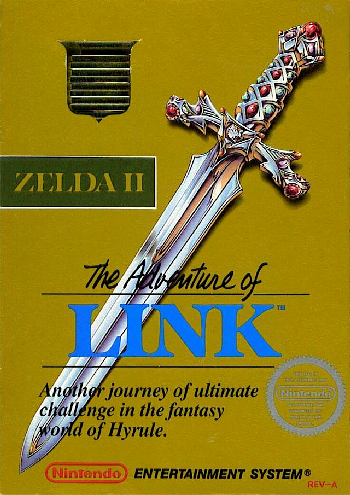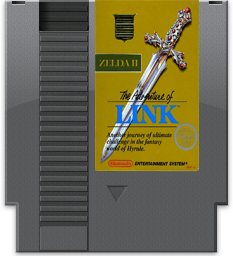

Zelda II: The Adventure of Link, released in 1987 for the Nintendo Entertainment System (NES), was a highly anticipated sequel to the groundbreaking original Legend of Zelda. Departing from its predecessor's top-down perspective, Zelda II took a bold approach by incorporating side-scrolling gameplay and RPG elements. While it certainly offered a unique experience, the game received mixed reviews and divided the fan base. Let's delve into the different aspects of Zelda II and assess its strengths and weaknesses.
Year: 1988
Manufacturer: Nintendo
Genre: RPG
Rating: HSRS - GA (General Audience)
Gameplay:
Zelda II introduced a significant departure from the gameplay style that made the original title so popular. The game featured a mix of side-scrolling action and RPG elements, including experience points, leveling up, and a sprawling overworld map. Link could now jump, stab in different directions, and learn new sword techniques as he ventured through various towns, palaces, and dungeons.
While the combat was engaging and provided a challenging experience, the side-scrolling segments often felt repetitive and lacked the sense of exploration and discovery seen in the original Zelda. The RPG elements, on the other hand, added depth to the gameplay, offering players the ability to customize Link's abilities and progress through the game at their own pace.
Story and World:
Zelda II continued the story of the original game, as players once again took control of the valiant hero, Link. The narrative delved deeper into the lore of the kingdom of Hyrule, introducing new characters and expanding on the Triforce mythology. The game's world was vast and interconnected, with towns, palaces, and dungeons scattered throughout.
However, the lack of clear direction and vague hints often left players feeling lost and frustrated. The game relied heavily on players' willingness to explore and engage in trial and error, which could be both rewarding and frustrating at times. The world design, while ambitious, lacked the seamless and intuitive nature of its predecessor.
Graphics and Sound:
For an NES title, Zelda II showcased impressive visuals. The environments were richly detailed, featuring varied landscapes and atmospheric dungeons. The character sprites were well-animated, and the boss designs were memorable. The soundtrack, although not as iconic as the original Zelda's, had its moments of charm, effectively enhancing the game's atmosphere.
Replay Value:
Zelda II offered a considerable amount of replay value through its nonlinear gameplay and the ability to customize Link's abilities. With multiple paths to explore and secrets to discover, players were encouraged to revisit the game to uncover its hidden depths. However, the difficulty level and occasional frustrations might deter some players from giving it another playthrough.

Explore in-depth reviews and analyses of classic Nintendo Entertainment System (NES) games, including gameplay mechanics, graphics, sound, and overall nostalgic experience.